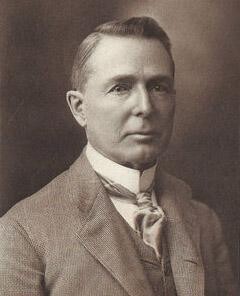Frederick Marion (F.M.) Hubbell purchased Terrace Hill in May of 1884 for $60,000, approximately one-fifth of what it cost Benjamin Franklin Allen to build the house in 1869.
Hubbell came to Fort Des Moines from Connecticut on May 7, 1855, at the age of 16. His rise to fame and fortune was equally as phenomenal as Allen’s and considerably more lasting.
Hubbell’s Business Interests

The day after his arrival in Fort Des Moines, Hubbell found work at the United States Land Office where Phineas Casady hired him to work for $100 a year plus board. A self-taught lawyer, Hubbell became a partner in the law firm of Casady & Polk, later known as Polk & Hubbell, in 1862.
It was during the 1860s and 1870s that Hubbell began building his real estate empire in Des Moines by buying property in the downtown area and also in a valuable industrial district known as the Factory Addition. Beyond real estate, Hubbell was instrumental in many industries in early Des Moines.
In 1866, Polk & Hubbell financed the building of the first streetcar line in Des Moines. Within three years, they organized a company to continue construction of the Iowa and Minneapolis narrow-gauge railroad to Ames. The Equitable Life Insurance Company was founded in 1867, with Hubbell as its first secretary. He was elected president in 1888 and remained at the helm until 1907 when he became chairman of the board. In 1871, Polk & Hubbell established the waterworks for Des Moines, and Hubbell held the controlling interest in the company until 1919 when the city purchased the system.
The F.M. Hubbell Family
Hubbell married Frances Cooper in 1863. F.M. and Frances had three children:
- Frederick Cooper Hubbell (born in 1864)
- Beulah Cooper Hubbell (born in 1874)
- Grover Cooper Hubbell (born in 1883)
The family made Terrace Hill the setting for many social and historical events including the lavish 1899 wedding of Beulah Hubbell to Swedish Count Carl Wachtmeister. Their wedding was held in the drawing room at Terrace Hill and provided the family with international recognition.
The Hubbells & Terrace Hill: Leaving a Legacy
F.M. Hubbell was extremely fond of Terrace Hill. The home received exquisite care in his hands. After the Hubbells moved in, mechanical systems were updated, plumbing was modernized, and a central heating plant was installed near the carriage house.
Hubbell created a trust in 1903 to protect his assets, including Terrace Hill. Under the terms of this document, the possession of the house passed to the eldest male heir.
The Hubbells celebrated their 61st wedding anniversary at Terrace Hill in 1924. Frances died later that year. After her death, Grover Hubbell, the Hubbells’ second son, and his family moved into the house to care for his aging father.
“When I first moved to Terrace Hill, the house seemed enormous, cavernous, mysterious—even a little frightening,” Grover’s daughter Mary Belle Hubbell Windsor remembered. “But I had the freedom to explore and to play as I wished, and so my fears were gone quickly.” Mary Belle also recalled that Grover, “…loved Terrace Hill as much as my grandfather did,” but the father and son differed on what “maintaining and preserving” Terrace Hill meant.
When Grover undertook modernizing the house in the mid-1920s, F.M wrote, “A lot of men are tearing the house to pieces according to Grover’s wishes. They claim to be improving it. I don’t like it.” Grover initiated extensive renovations:
- An elevator was installed in the former music room.
- The heating plant was moved into the basement.
- The house was structurally stabilized and electrified.
- A swimming pool was added east of the house.
- A pergola was installed in the formal garden.
The bill for this work came to over $50,000.
F.M. lived in Terrace Hill until his death in 1930. At that time, the eldest male heir, Frederick Cooper, chose not to take up residence in the home.
Grover and his family continued living in Terrace Hill and made many memories throughout the years, including moon lit dance parties on the south lawn, lavish marriages and receptions for his daughters, and yearly Christmas celebrations.
Family tradition at Terrace Hill deepened with the coming of grandchildren and great-grandchildren.
Terrace Hill housed one last grand event in 1955, Grover and Anna Hubbell’s fiftieth wedding anniversary. A year later Grover died, and Terrace Hill’s future was jeopardized. Values and attitudes had changed, and large homes were considered impractical for modern family use.
After Anna Hubbell dispersed Terrace Hill’s furnishings to family members and moved to an apartment in 1957, none of the Hubbell heirs wished to make the mansion their home.
In 1971, the Hubbell family donated Terrace Hill to the State of Iowa.